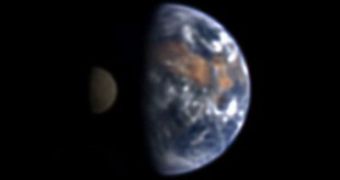NASA's comet chaser Deep Impact became famous on July 4, 2005 as the first spacecraft in the history of space exploration to collide an impactor into the nucleus of a comet in order to study its internal composition. As it turns out, Deep Impact provided recently two short films showing how our planet and its moon look like from a distance of about 50 million kilometers away, or 0.3 astronomical units, allowing us to see how our Earth would appear through the eyes of an intelligent alien species.
The two films show how the Moon transits the planet in its orbit and will be used as a starting point to create new methods through which other distant planets in the galaxy will be studied. "Making a video of Earth from so far away helps the search for other life-bearing planets in the universe by giving insights into how a distant, Earthlike alien world would appear to us," said Michael A'Hearn of the University of Maryland, the project leader of the spacecraft.
After its original assignment involving the study of the 9P/Tempel comet was completed, NASA engineers developed two new missions for the spacecraft. The first is known as Extrasolar Planet Observations and Characterization, or EPOCh for short, with the role of finding extrasolar planets through astrometry and transit methods while the other, the Deep Impact eXtended Investigation (DIXI), which will involve the study of Comet Hartley 2. The two extended missions are known under the name of EPOXI.
"Our video shows some specific features that are important for observations of Earthlike planets orbiting other stars. A "sun glint" can be seen in the movie, caused by light reflected from Earth's oceans, and similar glints to be observed from extrasolar planets could indicate alien oceans," said Drake Deming of NASA's Goddard Space Flight Center.
The images were in fact captured in May, but have been compiled into the two films only recently. One of the two is a composite video in which the visible red wavelengths are missing and have been replaced with infrared, to emphasize the presence of plants, which strongly reflect light in the infrared spectrum, and would be otherwise invisible in the optical wavelengths from such a great distance.
To some 50 million kilometers may seem like a lot, but in fact this distance is roughly equal to the one between Venus and Earth, in contrast with the distance between Earth and the closest star besides the Sun, Proxima Centary, which can be found about 40 trillion kilometers away, or 4.2 light years.
"To image Earth in a similar fashion, an alien civilization would need technology far beyond what Earthlings can even dream of building," said Sara Seager, a planetary theorist at the Massachusetts Institute of Technology.

 14 DAY TRIAL //
14 DAY TRIAL //